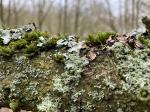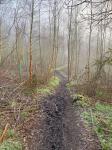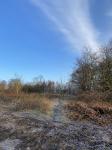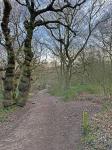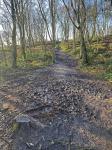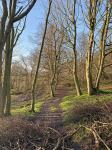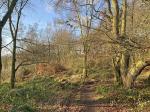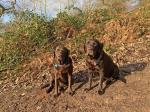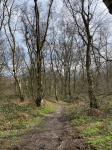Brayton Barff Through the Seasons.
Set in the Vale of York, South West of the market town of Selby and between the villages of Thorpe Willoughby and Brayton, lies Brayton Barff, a sandstone Hill approximately one hundred and fifty feet in height which was formed by glacial movement during the last Ice Age. It is a significant landmark in an otherwise flat landscape.
Today the site is primarily owned by Yorkshire Water with Selby District Council owning a small patch of the land adjacent to the A63 Selby bypass. A large underground reservoir occupies the centre of the site which delivers water to around 4.7 million customers throughout Yorkshire.
Within the Barff woodland over 40% of the trees are Sessile Oak which are generally found in semi natural woodlands in the north of the country. These trees are so called because its acorns are not held on stalks, like those of the English Oak (Pedunculate), but attached directly to the outer twigs. There are also several English Oak trees as well as some cross-hybrid oaks. These trees are known to support many species of flora and fauna, invertebrates, mosses, lichen and fungi.
During the Victorian times it is thought that the shipbuilders on the east coast would come over to the Barff for selected cuts of timber to build their sea going vessels.
The Barff also has a variety of other trees including Silver Birch, Beech, Sycamore, Holly, Rowan, Scots Pine, Alder, Hawthorne and European Larch. There are also several Yew, Willow, Hazel, Horse Chestnut and Wych Elm. As with similar woodlands there are a variety of bushes, including Honeysuckle, Elderberry, Gorse, Broom and Buddleia.
The history of Brayton Barff is quite vague, apparently during 1803 a beacon was lit on the Barff when the country was threatened with an invasion by Napoleon. In May 1935, to celebrate King George V's Silver Jubilee, a Bonfire was lit on the Barff as part of the celebrations.
Early issues of Ordnance Survey Maps dated 1903 clearly show a rifle range on the Barff, extending out to Mill Lane. During the 
Between 2001 – 2004 the A63 Selby bypass, 10km twin lane single carriageway was constructed which severed the South West corner of the Barff, adjacent to Selby Golf Course and resulted in a slight redesign of several holes on the golf course. Wooden fencing was erected as a result of this new road running alongside of the Barff and a footbridge constructed over the ‘new road’ following the line of the Bridal way which extends from Mill Lane. Around 2005/2006 a definite 2metre wide limestone aggregate footpath was laid forming a circular path around the outer edges of the woodland. This footpath is approximately 1.2 miles in length and takes about 30 minutes to circumnavigate at a leisurely pace.
In 2012 the Barff was declared an Ancient Oak Woodland and as such throughout 2012 and 2013 significant work had been carried out by the relevant agencies to cut and remove large swathes of non-native trees, creating at that time huge scars on the landscape. Some three years later the planting of the native trees have become well established and are flourishing. Ongoing maintenance work on the footpath around the bottom of the Barff was completed during the Summer of 2016.
A second phase of woodland maintenance commenced during the Autumn of 2019 with the removal of many old and diseased trees and the cutting back of the Gorse and Broom bushes, especially adjacent to the ‘bypass trail’, this work continued through till March 2020 with re planting continuing into April 2020.
Brayton Barff is a popular site for walkers and bird watchers alike and a path circling the outer perimeter of the Barff makes a pleasant thirty minute walk, giving views looking over towards Selby and the village of Brayton as well as the power stations of Drax and Eggborough..jpg)
For the early risers it is a great place to see some stunning sunrises over the villages of Brayton looking towards Drax Power Station, the same with the Sunsets looking over towards Eggborough and Monk Fryston.
The Barff changes with the Seasons and every visit can reveal something new, the woodland is a haven for wildlife. Records show that since 1982 one hundred and twelve species of bird have been seen in the woodland and at least 40 of those have bred here, including Tawny Owl, Buzzard, Green Woodpecker, Spotted Flycatcher, Goldcrest and Nuthatch to name just a few. On average over 70 species of bird are recorded each year. Further details of the bird life on the Barff can be found on the Brayton Barff Group Facebook page, especially the posts from Derek Cooper. Today ‘The Friends of Brayton Barff group’ led by Derek and a small team of volunteers help keep and maintain the cleanliness of the site as well as recording the wildlife and bird sightings.
The Barff is also home to fifteen different species of mammals, including Muntjac Deer, Pipistrelle Bat, Fox, and Field Vole.
Over eighty species of plant and wildflowers have been recorded, included Bee Orchid, Northern Marsh Orchid, Wood Anemone, Marsh Ragwort, Bluebell, White Bluebell, Bittersweet and Purple and White Foxgloves. Over twenty species of Butterfly have been recorded, including Marbled White, Brown Angus, Speckled Wood, Comma and Brimstone.
During the Autumnal months fungi thrives in this woodland environment, species including Fly Agaric, Beefsteak Tree Fungi, Chicken of the Wood, Sulphur Tufts, Stinkhorn, Ink cap, Puffballs and Hoof Bracket are just some of the many varieties that can be found here.
Click on the galleries shown below to expand the albums.
March 2020
After a very wet February, March was much drier. The daffodils around the Barff were flowering nicely and towards the end of the month the Bluebells were beginning to come into flower too. We had frosts for the first week of March, fortunately this helped with the drying process on the woodland floor although one of our neighbouring village of Snaith was still suffering from the recent flooding.
The second week of March was very wet with heavy overnight rain on several evenings which left the Barff like a quagmire again. Fortunately, the weather started to get a little bit milder. It was nice to hear the Chiffchaff returning after their winter in warmer countries, I heard my first one on around Sunday 9th. The same weekend one or two of the Bluebells were beginning to come into flower. I also spotted a huge Octopus fungi, that had grown on one of the decaying Silver Birch trees. Another strange fungi that had just appeared was a Slime fungi, most unusual in appearance as it looks as though someone has just sprayed an aerosol of white shaving foam on the tree trunks. It was nice to see some Redpoll on the Barff too, along with some Siskin.
Interspersed with all this cold and wet weather of late, we have had some lovely sunrises in March, the mornings are now getting much lighter and towards the end of the month the sunrise is around 5.55am.
Due to the ongoing Coronavirus Pandemic, Yorkshire Water closed the Barff car park on the 25th, in line with the governments guidelines and on the 26th announced a ban on driving to take your dog for a walk, all exercising had to be done close to home. Fortunately, I am still able to walk to the Barff from home inline with my daily exercise guidelines as issued by the government.
I have heard the Nuthatch calling most days throughout the winter months on the Barff and towards the end of the month became more and more vocal which was really nice to hear, they seem to be resident birds now. On the 25th I had a second visit to the Barff, around lunchtime, and watched a juvenile Kestrel for about five minutes as it flew from tree to tree around a small opening amongst the woodland. I am amazed at the number of Chiffchaffs around at the moment, they have, this past few days just arrived from the Mediterranean and West Africa and have settled amongst the Silver Birch wood, hopefully they will stay and spend the Summer with us on the Barff.
At the moment the Coltsfoot is flowering, with lots of small yellow florets, the blue petals of Sweet violet are a welcome sight at this time of the month too, as they provide an early source of nectar for the Butterflies. Another early flowering spring flower is the Wood Anemone which like the violets is one of the first to come into flower and is quite at home flowering before the main tree canopy forms, great to see amongst our ancient woodland.
Towards the end of the month the Bluebells are coming into flower at an alarming rate, I certainly notice a difference on a daily basis and especially after overnight rain. It is nice to see small swathes of Lesser Celandine; this ground hugging plant has tiny yellow florets and provides an early nectar source for Bees. Along the Bypass trail the Broom bushes are flowering nicely, their yellow florets glistening after the overnight rain, during the summer months once the Broom florets have dried out and turned to seed you can hear the plants creaking and groaning as the seed pods explode in the warmth of the summer sun.
It is interesting to note, the last week of March has seen a distinctive lack of visitors to the Barff because of the ‘travel ban’ so to speak, which has led to an increase in wildlife, especially the Grey Squirrels, they can quite frequently be seen running and playing along and across the main footpath around the woodland whereas before the ban tended to stop in the relatively safe haven amongst the trees. I have also seen at close hand a couple of Roe Deer one near to the perimeter footpath that was in full panic mode, fortunately it settled down and retreated into the dense undergrowth.
The old Oak trees are just coming into leaf and are full of buds at the moment, over the next few days they will burst open and totally transform the Barff’s tree canopy.
With a considerable reduction in vehicular traffic around the Barff at this time, it is nice to be able to hear the Song Thrush, Yellow Hammer and Blackcap, all have a distinctive call, and are quite vocal early in the morning, the Blackcap have just (30th) arrived from North Eastern Europe.
Here’s hoping the Coronavirus pandemic starts to slow down over the next few weeks.
|






